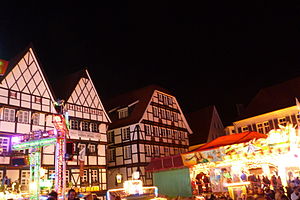Allerheiligenkirmes

The Allerheiligenkirmes ("Allerheiligen": engl. "All Saints", "Kirmes": engl. "fun fair") in the German city of Soest in the state of North-Rhine Westphalia is the biggest fun fair in a historic city in Europe and takes place for five days annually in the historic centre of the town.
History[edit]
The Allerheiligenkirmes is the oldest public festival in the state of North-Rhine Westphalia. In 2019 it has been celebrated for the 682nd time. Gerhard Köhn, an archivist from the municipal's archive: "The funfair's history could go back to these times (around 1100). But its first record in writing is from 1338 on the oldest preserved bill of the city written on parchment. On this we can find a plain, barely legible record saying 'Item de wrighe kermesse constat VI s.' (Besides the free funfair costs 6 schilling)."
About the Allerheiligenkirmes[edit]
The funfair has around 1.3 million visitors annually (in 2019: 1.3 million[1]) on five days. Because of it taking place between old half-timbered houses and churches its atmosphere is often referred to as 'homely' and many people who once moved away from Soest come back to the town during this time.
Symbolic figure of the Allerheiligenkirmes is the 'Soester Jägerken', of figure based of Simplicius Simplicissimus.
The first Allerheiligenkirmes was celebrated due to the parish fair of the St.-Petri-Kirche (St. Petri Church) in Soest.

Schedule of the Allerheiligenkirmes[edit]
The Allerheiligenkirmes is officially opened every first Wednesday after Allerheiligen (All Saint's Day, 1. November) at 2 pm by the town's mayor through the tapping of a barrel. In 2010, for the first time, a so-called 'soft start' was established, meaning that the showmen and carrousels could already open in the morning. On Wednesday the carrousels are open until midnight. As on most of the days, that only means the end of the funfair on the streets of the city, as it usually continues in pubs and bars until the early hours of morning.

On Thursday morning from 8 am to 2 pm the "Pferdemarkt" (engl. horse market) takes place. Due to this parts of the town centre are being closed down for cars and merchants open their booths. On some of the roads agricultural utility vehicles are shown. Shops, schools, offices and bands in Soest are mostly closed on that day. During the last years the "Bullenschätzen", a game in which players have to estimate the weight of a living bull, did not take place anymore. Instead, the "Pferdeschätzen" takes place, where players have to estimate the weight of a cold-blood horse. On Thursday, the funfair officially ends at midnight.
On Friday, a firework takes place at 7 pm. It is now launched behind the train station of Soest, where it was moved to from the town centre. In 2006 the firework was tentatively launched on Wednesday and Friday and was combined with a lasershow. Therefore it was placed into the town centre again and could only be fired on a lower height. Due to that it was only visible for relativley few people and the city received a lot of complaints by its citizens and visitors, who could not see the fireworks from their usual places of watching. The launching was placed back to the city fringe and can now be seen from almost the whole area of the funfair.
On Friday and Saturday the funfair is opened until 2 am. Saturday and also Sunday are usually the days with the most visitors.
Sunday is mostly seen as a day for families to visit the funfair. On Sunday it is officially opened until 10 pm.
Characteristics of the Allerheiligenkirmes[edit]
"Bullenauge"[edit]
The typical drink of the Allerheiligenkirmes is the so-called "Bullenauge" (engl. bull's eye), a mocha liqueur that got its name from the way it looks. Into a glass of mocha liqueur cream is added in a way that, with a bit of fantasy and slight blowing, the image looks like a bull's eye.
"Der Dudelmann"[edit]
"Der Dudelmann" is a liqueur that is only served at the Allerheiligenkirmes. It has received an iconic status, not only because of the drink, but also because it hands out stickers with funny sayings ("Trinkst du den Dudelmann auf Ex, hast du den allerbesten Sex", engl. "If you drink the Dudelmann in one go, you will have the best sex"). The history of the Dudelmann started in the mid-19th century, when the wine merchant Ignaz Lücking created the recipe for the liqueur.

"Amelunxen"[edit]
The "Amelunxen" is a booth for honey liqueur ("Karussell ohne Hydraulik", engl. "carrousel without hydraulics"), which is produced by a beekeeper from Soest and served in eatable shot glasses made of waffles and chocolate. The booth is also seen as special, because during the whole time of the funfair the operator is standing behind the counter with a microphone, passing funny comments of singing along to German schlager music.
"Topfmarkt"[edit]
Part of the Allerheiligenkirmes is a big "Topfmarkt" (engl. "pot market") for household goods. It can usually be found on a market place called "Vreithof" behind the town hall.
"Pott's historischer Jahrmarkt"[edit]
Since 2007 the "Pott's Brauerei" (Pott's Brewery) hosts a "historischer Jahrmarkt" (engl. "historic fair") close to Soest's market place. Different attractions can be found, such as egg tossing, shooting with bow and arrows, mead booths, barbeque booths, booths for bits and pieces and jewellery as well as medieval music and juggleries and a music group called "Die Streuner".
Incidents[edit]
In 2012 a 50-year-old man died of injuries after a fight at the funfair.[2]
References[edit]
- ↑ "Die große Bilanz: "Jahrhundertkirmes" lockt 1,3 Millionen Besucher". www.soester-anzeiger.de (in Deutsch). Retrieved 2022-07-22.
- ↑ "50-Jähriger erliegt schweren Verletzungen". www.soester-anzeiger.de (in Deutsch). Retrieved 2022-07-22.
External links[edit]
- Commons: Allerheiligenkirmes – Collection of images, videos and audio data
- Allerheiligenkirmes auf nrw-tourismus.de
This article "Allerheiligenkirmes" is from Wikipedia. The list of its authors can be seen in its historical and/or the page Edithistory:Allerheiligenkirmes. Articles copied from Draft Namespace on Wikipedia could be seen on the Draft Namespace of Wikipedia and not main one.
